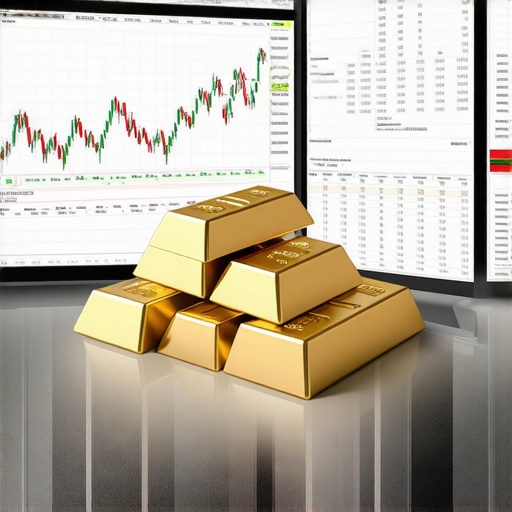Gold: The Timeless Investment Darling That Never Goes Out of Style
Imagine this: you’re at a bustling market, surrounded by the clamor of traders, yet your portfolio quietly gleams with the stability of gold. Gold has long been the go-to asset to hedge against inflation, market volatility, and economic uncertainty. But in 2025, with the financial landscape evolving rapidly, how do you craft a balanced gold portfolio that leverages both ETFs and stocks without tipping the scales too far?
Mixing Bullion and Bytes: Why Not Both?
Let’s be clear: investing in gold isn’t just about stashing shiny coins under your mattress anymore. Exchange-Traded Funds (ETFs) offer liquidity and diversification, while gold mining stocks introduce growth potential tied to corporate performance. Combining these two can create a symphony of stability and upside. But how do you strike that perfect chord?
Is It Better to Hold Physical Gold or Ride the Wave of ETFs and Stocks?
That’s the million-dollar question, isn’t it? While physical gold offers tangible security, ETFs provide ease of trading and reduced storage hassles. Gold stocks, on the other hand, can amplify returns but carry company-specific risks. For many investors, a mix is the sweet spot, balancing safety with growth potential.
For those wanting to dive deeper into selecting ETFs tailored to diversified portfolios, this guide to choosing the best gold ETFs is a treasure trove of insights. Meanwhile, pairing that with savvy picks in gold stocks can enhance your portfolio’s resilience and returns.
Lessons from the Trenches: My Personal Journey
Years ago, I was skeptical about gold stocks. Too volatile, I thought. But after studying market cycles and observing gold demand trends, I realized the nuanced dance between physical assets and equities. A balanced approach, informed by current market analysis, is key. According to a recent Investopedia article, gold remains a critical hedge during economic downturns, underscoring its timeless appeal.
It’s not just about picking the right assets but understanding how to allocate them smartly. Think of it as seasoning a dish — too much of one spice can overpower the meal. Similarly, a portfolio overly weighted in either gold ETFs or stocks can miss opportunities or expose you to unnecessary risks.
Crafting Your Portfolio: The Balancing Act
Start with a base of gold ETFs, which track the price of gold closely and offer liquidity. Then, sprinkle in gold mining stocks for growth potential. As a rule of thumb, many experts suggest allocating around 60% to ETFs and 40% to stocks, but your personal risk tolerance and goals should guide your mix.
Curious how to weave this strategy into your overall investment plan? Explore this article on balancing gold and stocks that delves into practical steps for portfolio harmony.
Are You Ready to Let Gold Shine in Your Investment Strategy?
Gold’s allure isn’t just nostalgia; it’s about smart diversification with a golden twist. Whether you’re a cautious investor or a daring trader, blending ETFs and stocks can equip your portfolio to weather storms and seize growth.
What’s your take? Have you ventured into gold ETFs or stocks, or do you prefer physical gold? Share your experiences and thoughts below — let’s strike gold together in the comment section!
Beyond Basics: Integrating Macroeconomic Indicators into Gold Investment Decisions
Understanding the macroeconomic backdrop is pivotal when balancing gold ETFs and stocks. Inflation rates, interest rate changes, and geopolitical tensions are not just headlines—they directly impact gold’s price dynamics and investor sentiment. For instance, rising inflation typically boosts gold’s appeal as a hedge, whereas increasing interest rates might dampen its attractiveness compared to yield-bearing assets.
Investors should monitor central bank policies closely, especially major players like the Federal Reserve, as their decisions ripple through gold markets worldwide. Incorporating insights from Investopedia’s macroeconomics overview can enhance strategic timing and allocation between ETFs and mining stocks.
Risk Mitigation Techniques: Navigating Volatility with Tactical Adjustments
Volatility is inherent in gold mining stocks due to operational risks, commodity price fluctuations, and corporate governance factors. One effective approach is implementing stop-loss orders or using options strategies to hedge against sudden downturns. Conversely, gold ETFs generally exhibit lower volatility but may lag in capitalizing on sharp price rallies.
To optimize risk and return, consider periodic portfolio rebalancing informed by market signals and personal risk tolerance. This dynamic management can protect gains and limit exposure during turbulent periods.
How Can Advanced Traders Leverage Gold Futures Alongside ETFs and Stocks?
Gold futures offer a powerful tool for seasoned investors seeking leverage and precise exposure to gold price movements. When combined thoughtfully with ETFs and mining stocks, futures can amplify returns or provide downside protection through hedging. However, futures trading demands a sophisticated understanding of contract specifications, margin requirements, and timing.
For those interested in exploring this complex terrain, our gold futures trading guide lays out essential strategies for maximizing profit potential while managing risks effectively.
Expert Insight: The Growing Role of ESG in Gold Mining Stocks
Environmental, Social, and Governance (ESG) considerations have surged in importance among gold mining companies. Investors increasingly favor firms with robust sustainability practices, which can influence stock performance and long-term viability. Integrating ESG factors into your stock selection process not only aligns with responsible investing principles but may also mitigate reputational and regulatory risks.
Research from MSCI on ESG in mining highlights how companies with strong ESG metrics often outperform peers in volatile markets, underscoring the strategic value of this lens.
Engage With Us: Share Your Gold Investment Approach and Discover New Perspectives
How do you currently balance your gold investments among physical assets, ETFs, and stocks? Have you experimented with futures or incorporated ESG criteria into your selections? Join the conversation by leaving a comment below—we’re eager to hear about your strategies and experiences. Also, if you want to deepen your understanding, explore our extensive resources like the best gold ETFs for diversification and top investment strategies for 2025. Sharing knowledge empowers us all to strike gold in our financial journeys!
Decoding Gold’s Dance with Global Macroeconomic Forces: A Strategic Investor’s Playbook
Gold’s price dynamics are a complex ballet choreographed by the interplay of inflation trends, currency fluctuations, geopolitical tensions, and central bank maneuvers. In 2025, this dance has become even more intricate, demanding investors to sharpen their analytical toolkit beyond mere price charts. For example, understanding the inverse correlation often observed between the US dollar strength and gold prices enables savvy allocation timing. Additionally, recognizing how quantitative tightening policies might tighten liquidity can pre-empt shifts in gold demand across ETFs and mining equities.
Integrating macroeconomic data streams—such as Purchasing Managers’ Index (PMI) reports and Consumer Price Index (CPI) trends—can provide a nuanced edge. Investors who harness these indicators proactively can recalibrate their gold holdings to anticipate market inflections, rather than merely react to them.
How can nuanced macroeconomic analysis optimize timing and allocation between gold ETFs and mining stocks?
By dissecting macroeconomic signals, investors can differentiate periods when physical price exposure via ETFs is preferable versus when mining stocks, which are often more sensitive to operational leverage and capital expenditure cycles, may outperform. For instance, during inflationary spikes paired with political instability, ETFs might offer safer harbor, whereas in phases of economic recovery with rising gold prices and stable currencies, mining stocks can deliver amplified returns.
Deepening your understanding of these macroeconomic linkages is not just academic—it’s a practical imperative. Resources such as the CFA Institute’s research on macroeconomic factors influencing gold prices provide invaluable empirical insights that refine portfolio decision-making.
Dynamic Risk Management: Tactical Adjustments in a Volatile Gold Market
Gold mining equities are inherently more volatile due to operational risks, geopolitical exposure, and fluctuating commodity prices. To navigate this volatility, advanced investors employ tactical adjustments such as dynamic stop-loss thresholds, options-based hedging strategies, and volatility-targeted rebalancing. For example, protective puts on gold mining stocks can cap downside risk during market corrections while retaining upside exposure.
Conversely, gold ETFs, which closely track the bullion price, exhibit lower volatility but might underperform in rapid bull markets. Incorporating volatility metrics such as the VIX or gold-specific implied volatility indices can inform timing for tactical shifts between ETFs and stocks, optimizing the risk-return profile.
ESG Integration in Gold Mining Stocks: A New Frontier for Sustainable Alpha
The surge of Environmental, Social, and Governance (ESG) criteria has reshaped how investors evaluate gold mining companies. Beyond traditional financial metrics, ESG factors—ranging from carbon footprint reduction initiatives to community engagement and governance transparency—now materially impact stock valuations and risk profiles.
Studies reveal that companies with robust ESG practices often demonstrate superior operational resilience, reduced regulatory penalties, and stronger brand loyalty, which collectively enhance long-term shareholder value. For example, MSCI’s research on ESG in mining underscores how ESG-integrated portfolios have outperformed peers, particularly during commodity price downturns.
Investors can leverage ESG ratings and sustainability reports to refine stock selection, aligning ethical considerations with financial objectives and mitigating latent risks that traditional analysis might overlook.
Mastering Portfolio Synergy: Combining Fundamental Analysis with Tactical Execution
Crafting a gold portfolio that thrives in 2025’s fluid market conditions requires more than static asset allocation. It demands an agile framework that synthesizes fundamental macroeconomic insights, rigorous risk management, and ESG diligence with tactical execution. This might involve adjusting ETF-to-stock ratios based on real-time economic indicators or selectively deploying futures contracts as hedges during anticipated volatility spikes.
Such sophistication transforms gold investment from a passive hedge into an active wealth-building strategy—one that can capitalize on nuanced market shifts and evolving investor priorities.
Engage with these advanced concepts and elevate your gold investment approach. Curious to learn how tactical rebalancing and ESG integration can reshape your portfolio? Dive into our comprehensive expert resources and join our community for ongoing insights and strategy discussions.
Macroeconomic Nuances: Elevating Gold Investment Strategy Beyond the Obvious
Seasoned investors recognize that gold’s price movements are far from random; they are deeply entwined with a web of macroeconomic forces. Inflation remains the classic catalyst, yet understanding its multifaceted relationship with real interest rates, currency strength, and global liquidity conditions is where true expertise lies. For example, while rising inflation often boosts gold’s appeal, the simultaneous rise in real yields can counterbalance this effect, leading to nuanced price behavior that challenges simplistic assumptions.
Similarly, geopolitical tensions—ranging from trade wars to regional conflicts—can abruptly shift gold’s safe-haven demand. Incorporating forward-looking economic indicators such as Purchasing Managers’ Index (PMI) trends or shifts in central bank balance sheets enables investors to anticipate, rather than merely react to, these price inflections. For a deep dive into interpreting gold’s macroeconomic signals, the CFA Institute’s research on macroeconomic factors influencing gold prices offers invaluable empirical insights.
How Can Investors Integrate ESG Metrics to Drive Alpha in Gold Mining Stocks?
Environmental, Social, and Governance (ESG) factors have transformed from a niche concern to a central pillar in gold mining stock evaluation. Companies that proactively manage environmental impact, engage positively with local communities, and uphold transparent governance standards tend to experience stronger operational resilience and reduced regulatory risks. This ESG premium increasingly translates into superior stock performance, particularly amid volatile commodity cycles.
Investors can harness ESG ratings from established providers to filter gold mining stocks, aligning financial objectives with sustainability goals. This dual focus not only mitigates latent risks but also taps into a growing wave of capital flows favoring responsible investments. For a comprehensive overview of ESG integration in mining, MSCI’s report offers compelling data linking ESG strength with market outperformance.
Mastering Tactical Portfolio Adjustments: Dynamic Rebalancing in Practice
Static allocation between gold ETFs and mining stocks can leave a portfolio vulnerable to shifting market regimes. Advanced investors deploy dynamic rebalancing strategies, adjusting exposures in response to evolving macroeconomic and market volatility signals. For instance, during inflation spikes paired with geopolitical uncertainty, increasing ETF allocations can preserve capital, while periods of economic recovery with increasing gold prices might favor a tilt toward mining equities to capture amplified upside.
Tools such as volatility indices and sentiment indicators can serve as triggers for these tactical shifts, enhancing risk-adjusted returns. Moreover, integrating stop-loss mechanisms and options hedges on mining stocks can further safeguard against downside shocks while maintaining participation in bullish runs.
What Role Do Gold Futures Play for Advanced Investors Seeking Portfolio Optimization?
Gold futures offer a sophisticated avenue for leveraging price exposure and executing precise hedging strategies. By combining futures contracts with ETFs and mining stocks, investors can tailor their risk profiles, amplify gains, or protect against downside risks with greater flexibility. However, futures trading demands a robust understanding of margin requirements, contract specifications, and timing nuances.
For those prepared to navigate this complexity, our gold futures trading guide provides expert strategies that balance profit potential with prudent risk management.
Engage and Elevate: Share Your Advanced Gold Investment Strategies
How are you integrating macroeconomic insights and ESG considerations into your gold portfolio? Have you experimented with tactical rebalancing or futures to enhance your exposure? Join the discussion below and share your experiences. For those keen on expanding their expertise, explore our curated resources on selecting top gold ETFs and initiating gold stock investments. Together, let’s refine our strategies and strike gold in 2025 and beyond!

Expert Insights & Advanced Considerations
Understanding the Cyclical Sensitivity Between Gold ETFs and Mining Stocks
Gold ETFs often provide direct exposure to bullion prices, exhibiting relatively stable performance during periods of economic uncertainty. In contrast, gold mining stocks are more sensitive to operational leverage and capital expenditure cycles, leading to amplified gains or losses depending on broader economic recovery phases. Recognizing these cyclical sensitivities allows investors to tactically adjust allocation ratios, optimizing for both capital preservation and growth.
Integrating ESG Criteria as a Catalyst for Sustainable Alpha in Gold Equities
Incorporating Environmental, Social, and Governance (ESG) metrics into gold stock selection is no longer optional but a strategic imperative. Companies with strong ESG profiles tend to outperform peers by mitigating regulatory risks, enhancing brand loyalty, and improving operational resilience. This integration not only aligns portfolios with responsible investing principles but also offers a potential edge in volatile commodity markets.
Leveraging Macroeconomic Indicators for Dynamic Portfolio Adjustments
Advanced investors employ real-time macroeconomic data—such as inflation trends, central bank policy shifts, and geopolitical developments—to calibrate exposure between gold ETFs and mining stocks. This proactive approach enables anticipation of market inflections, rather than reactive portfolio changes, thus enhancing risk-adjusted returns in fluctuating environments.
Employing Tactical Risk Mitigation Tools for Volatile Mining Stocks
Volatility in gold mining equities necessitates sophisticated risk management strategies including stop-loss orders, options hedging, and volatility-based rebalancing. Such tactics protect against downside shocks while maintaining participation in upward price movements, thereby optimizing the risk-return profile of the gold segment within a diversified portfolio.
Curated Expert Resources
- CFA Institute’s Research on Macroeconomic Factors Influencing Gold Prices: Offers empirical analysis linking inflation, currency strength, and central bank policies to gold price dynamics, essential for informed tactical allocation.
- MSCI’s Report on ESG in Mining: Provides comprehensive data and case studies illustrating how ESG integration correlates with operational resilience and market outperformance among gold miners.
- BuyingGoldNow’s Guide to Choosing the Best Gold ETFs for a Balanced Portfolio: A practical resource detailing ETF selection strategies tailored for diversification and stability.
- Gold Futures Trading Guide on BuyingGoldNow: Delivers advanced strategies for leveraging futures contracts alongside ETFs and mining stocks to enhance returns and manage risk.
- Top Gold Investment Strategies to Hedge Wealth in 2025: Explores diversified approaches combining macroeconomic insights, ESG integration, and tactical rebalancing for robust portfolio construction.
Final Expert Perspective
Balancing gold ETFs and stocks effectively in 2025 requires a nuanced understanding that transcends basic allocation models. By integrating macroeconomic insights, ESG criteria, and tactical risk management, investors can transform gold from a passive hedge into a dynamic growth catalyst within their portfolios. This sophisticated approach not only safeguards wealth during volatility but also positions portfolios to capitalize on emerging market opportunities.
For those ready to deepen their expertise, engaging with advanced resources and sharing insights within the investing community fosters continual growth and strategic refinement. Embrace this evolving landscape, and let your gold investments shine with informed confidence. Dive deeper into expert strategies at BuyingGoldNow’s ETF guide and explore long-term gold stock investment tactics to elevate your portfolio today.











I’ve been gradually building a gold portfolio over the last few years, initially favoring physical gold for its tangible security. However, after reading numerous analyses and observing market behaviors, I’ve shifted towards incorporating a mix of gold ETFs and mining stocks. The liquidity and diversification ETFs offer make them an essential foundation, but mining stocks add an exciting growth dimension, though with higher volatility.
What I find challenging is striking the right balance based on shifting macroeconomic factors, especially with inflation expectations and central bank movements constantly evolving. For instance, when inflation spikes and geopolitical tensions rise, I’ve tended to lean more heavily on ETFs as a safer haven. In periods of economic recovery, mining stocks have provided rewarding returns but require vigilant risk management.
I also appreciate the article’s mention of ESG considerations; integrating sustainability metrics has helped me identify mining companies with better long-term prospects and risk profiles. It feels like a smart way to align investment goals with responsible principles.
I’m curious how others approach adjusting their gold allocations dynamically. Do you rely mainly on economic indicators, market sentiment, or a fixed strategy? How do you manage the volatility in mining stocks while aiming for portfolio growth?